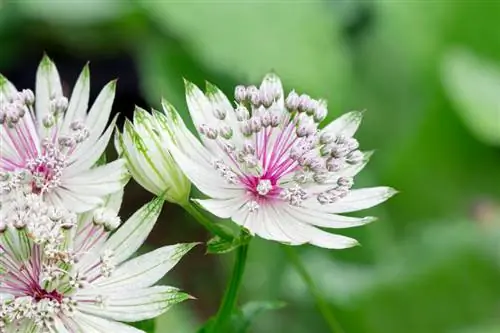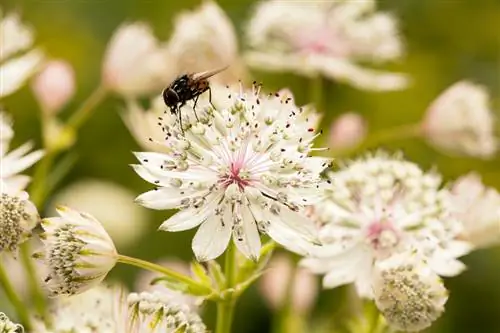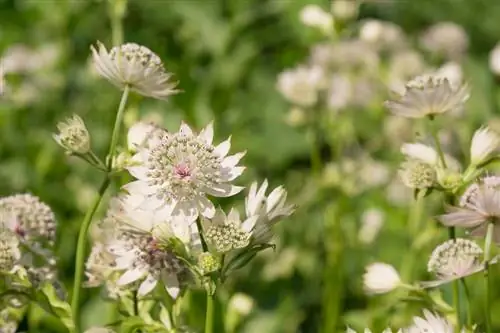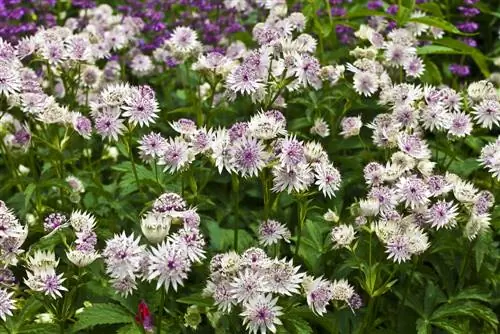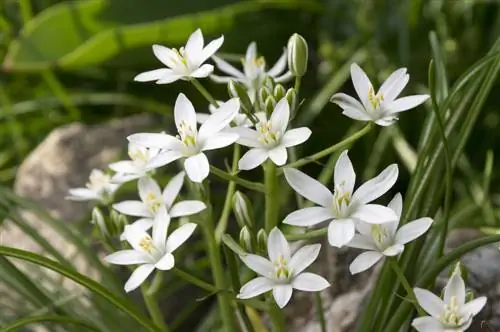- Author admin [email protected].
- Public 2023-12-25 17:45.
- Last modified 2025-01-23 11:21.
In the natural garden it is more popular than ever. Thanks to its diverse floral talents, the star umbel has made it one of the most popular summer perennials. The following answers to frequently asked questions provide you with everything that goes into skillfully planting and caring for the undemanding Astrantia.
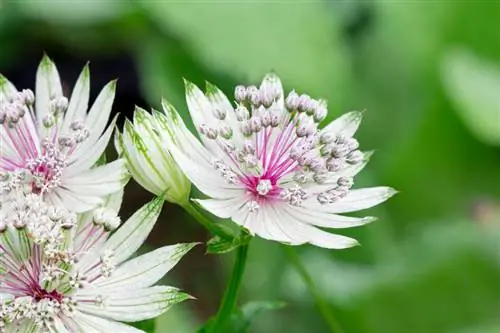
How do I properly care for a star umbel?
The star umbel is a popular summer perennial that thrives in partially shaded locations with fresh, moist, humus-rich soil. It requires regular watering, organic fertilizer and occasional pruning for abundant flowering and he althy growth. Spring and late summer are the ideal planting times.
Planting star umbel correctly
In spring and late summer it is planting time for the star umbel. Choose the location carefully, because an Astrantia will easily stay in semi-shady locations with fresh, moist, humus-rich soil for 10 years or longer. While you prepare the soil so that it is finely crumbled, the potted root ball is soaked in water. This is how the professional planting continues:
- Create spacious planting pits at a distance of 50-60 cm with 1.5 times the volume of the root ball
- Enrich the excavation with sifted compost (€12.00 on Amazon), horn shavings and a little vital lime
- Insert a potted root ball into each planting hole, maintaining the previous planting depth
It is beneficial for the vitality and abundance of flowers if you mulch the soil with leaves, grass clippings or bark mulch after watering.
Care tips
Proper care of an Astrantia is based on a few, uncomplicated measures. The following overview shows briefly and succinctly how you can get the best out of a star umbel:
- Never let the root ball dry out
- After the first bloom, cut an astrantia back 5 to 10 cm above the ground
- Fertilize organically in spring and after the first pruning
- In autumn, cut off the withered secondary flowers to prevent seeding
- Alternatively, cut the star umbel close to the ground in February to make room for the shoots
Winter protection is only necessary for perennials in planters so that the root ball does not freeze in the exposed position. Place a bucket or balcony box on wood in front of the south wall of the house and cover the container with jute, foil or garden fleece.read more
Which location is suitable?
The star umbel forms a congenial partnership with trees and ornamental shrubs. Since it prefers a semi-shady location, an Astrantia unfolds its natural beauty to perfection on the edge of the wood, in the perennial bed and in the rose bed. The sunnier the location, the more moisture the soil should contain. In addition, the summer perennial prefers to extend its roots in loose, humus-rich and calcareous soil.read more
The correct planting distance
The broad bushy habit of an Astrantia requires a generous planting distance. To ensure that a flower-rich clump is shown to its best advantage, we recommend a distance of 50 to 60 cm from the neighboring bed for the popular star umbel. Smaller species and varieties, such as the red star umbel, display decoratively at a distance of 40 to 45 cm.
What soil does the plant need?
Your demands on the soil properties hold no surprises. The Astrantia thrives easily in any normal garden soil that is humus, fresh, moist and has a nice, loose structure. The substrate can be a little calcareous, so add a handful of vital lime or rock dust to the pot of commercially available potting soil.
When is flowering time?
The summer umbelliferous plant spoils us with a colorful flowering period twice a season. After an Astrantia presents its pretty starry flowers in June and July, another bloom follows in September after pruning. Enjoy a picturesque appearance with hemispherical flowers that are reminiscent of a delicate pin cushion, star-shaped framed by delicate bracts. The feathery and toothed foliage is no less attractive.
Cut the star umbel correctly
In order to fully enjoy the floral talents of an Astrantia, professional pruning at the right time plays an important role. The following overview shows when and how secateurs are used on a star umbel:
- Cut flowers for the vase, bouquets and as dried flowers: umbel flowers that have just opened are cut in the morning hours
- Pruning for rebloom: In August, cut back Astrantia 5-10 cm above the ground
- Prevent seeding: After the second flowering period, cut off the withered flower stems to just above the foliage
- Main cut: Cut back close to the ground in late winter, in good time before the fresh shoots
If you want an Astrantia to go wild in a natural garden, simply leave the withered umbel flowers on the plant. The perennial takes care of the rest on its own.
Watering star umbel
In the wild, the Astrantia is mainly found in meadows and wetlands, because it doesn't do much well in dry conditions. Therefore, water the summer beauty abundantly and regularly without causing waterlogging. Where the rain contributes to the water supply in the bed, the watering can is used less often than in the airy pot substrate.
Fertilize star umbel correctly
A balanced supply of nutrients lays the foundation for lush flowers and a magnificent foliage. Ideally, you fertilize an Astrantia in March/April with ripe compost soil, horn shavings and a little rock dust. After the summer pruning, a further application of organic fertilizer provides a valuable jump-start for subsequent flowering. Cultivate the star umbel in the pot and apply a liquid fertilizer for flowering plants every 3 weeks from May to August.
Wintering
The star umbel is completely hardy in our latitudes, so no explicit precautions need to be taken in the bed. On the contrary, the Astrantia acts as overwintering protection for numerous beneficial insects. Since the root ball in the pot is more susceptible to frosty temperatures, place the container on wood and cover it in bubble wrap.
Propagate star umbel
In spring, the star umbel can be propagated wonderfully easily by division. After pruning, dig up the Astrantia and shake off all the soil. Place the root ball on a stable surface and cut it in half with a knife or spade. Further division is possible. As long as a segment has at least 2 buds, it will turn into an adult perennial within a short time. In a partially shaded location in loose, moist and humus-rich soil, plant the sections at a distance of 50-60 cm, maintaining the previous planting depth if possible.
Is star umbel poisonous?
Star umbels pose no he alth risk to humans or animals. The umbelliferous plant is therefore not only recommended for the idyllic design of natural beds. It is also a valuable part of the multi-faceted family garden, where children and pets can run around without a care in the world.
Beautiful varieties
- Abbey Road: Magnificent Astrantia with dark purple flowers in summer and autumn; Growth height 60-80 cm
- Florence: Richly flowering star umbel in iridescent colors from silver to pink to lavender; Growth height 40-60 cm
- Princesse Strudza: The Astrantia impresses with silvery-white flowers that grow up to 5 cm tall; Growth height 50-60 cm
- Rose symphony: The lushly blooming large star umbel unfolds dreamy flowers in light pink to red; Growth height 70 cm
- Sunningdale Variegated: Beneath pink flowers, the foliage changes from cream to green to yellow-brown in autumn

